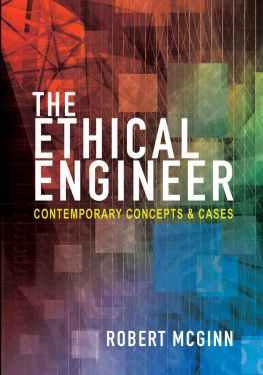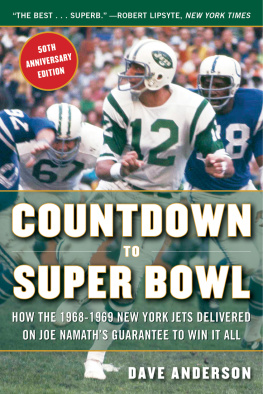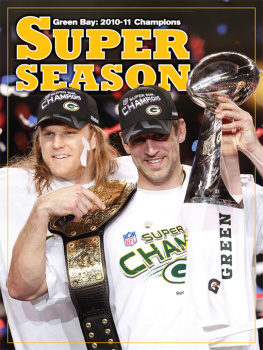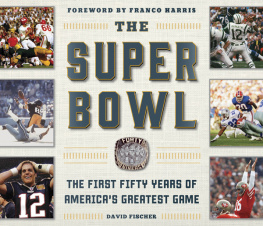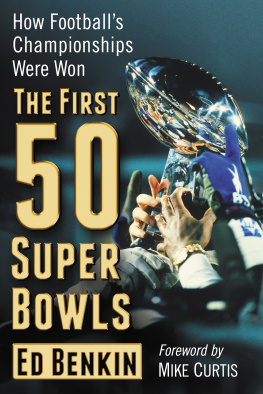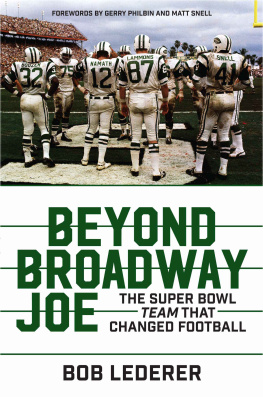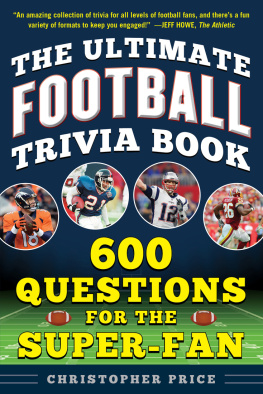THE ULTIMATE
SUPER BOWL BOOK
A COMPLETE REFERENCE TO THE STATS, STARS, AND STORIES BEHIND FOOTBALLS BIGGEST GAMEAND WHY THE BEST TEAM WON
2ND EDITION
Bob McGinn
Foreword by Michael MacCambridge

To my mother, Catherine: You taught me how to keep score of my first basketball game on the radio, made sure newspapers always were around the house, took me to sporting events big and small, and made certain good writing and good grammar were priorities.
To my father, Denis: You were my hero. Ill never forget taking the train with you to my first NFL game on Sunday, October 4, 1959, at City Stadium in Green Bay.
First published in 2009 by MVP Books, an imprint of MBI Publishing Company, 400 First Avenue North, Suite 300, Minneapolis, MN 55401 USA.
This second edition published 2012.
2009, 2012 MVP Books
Text 2009, 2012 Bob McGinn
Photograph copyrights as indicated with captions.
All rights reserved. With the exception of quoting brief passages for the purposes of review, no part of this publication may be reproduced without prior written permission from the Publisher.
The information in this book is true and complete to the best of our knowledge. All recommendations are made without any guarantee on the part of the author or Publisher, who also disclaims any liability incurred in connection with the use of this data or specific details.
This publication has not been prepared, approved, or licensed by the National Football League or its affiliates
We recognize, further, that some words, model names, and designations mentioned herein are the property of the trademark holder. We use them for identification purposes only. This is not an official publication.
MVP Books titles are also available at discounts in bulk quantity for industrial or sales-promotional use. For details write to Special Sales Manager at Quayside Publishing Group, 400 First Avenue North, Suite 300, Minneapolis, MN 55401 USA.
To find out more about our books, visit us online at www.mvpbooks.com.
Digital Edition: 978-1-61058-669-6
Hardcover Edition: 978-0-76034-371-5
Library of Congress Cataloging-in-Publication Data McGinn, Bob.
The ultimate super bowl book : a complete reference to the stats, stars, and stories behind footballs biggest game--and why the best team won / Bob McGinn ; foreword by Michael MacCambridge. -- 2nd ed.
p. cm.
ISBN 978-0-7603-4371-5 (hardback)
1. Super Bowl--History--Statistics. 2. Super Bowl--Miscellanea. I. Title.
GV956.2.S8M36 2012 796.332648--dc23
2012013087
Editors: Peter Bodensteiner and Josh Leventhal
Design Managers: Katie Sonmor and James Kegley
Layout Design: Greg Nettles and Trevor Burks
Front Cover Photo by Scott Boehm/Getty Images
CONTENTS
FOREWORD
by Michael MacCambridge
Shoat said it was too bad we would all have to miss it but the Super Bowl halftime show was going to be even more spectacular than the pre-game show.
He said there would be a water ballet in the worlds largest inflatable swimming pool, a Spanish fiesta, a Hawaiian luau, a parade stressing the history of the armored tank, a sing-off between the glee clubs of all the military academies, and an actual World War I dogfight in the sky with the Red Barons plane getting blown to pieces.
Dan Jenkins, Semi-Tough
Dan Jenkins wrote that send-up of the absurdity of Super Bowl halftime shows in 1972and hed be the first to tell you that, by 1974, the real thing had already outstripped even his healthy capacity for imagination.
From the beginning, there has been so much excess and bombast surrounding the Super Bowl that many people have come to the understandable conclusion that all the hype, sizzle, commotion, and distraction is what the event is truly about.
The way the game is presented by the NFL makes a kind of historical sense. When the AFL-NFL World Championship game was created, as part of the 1966 merger agreement between the two rival leagues, pro football was still straining to prove its supremacy. The models it was attempting to emulate and, ultimately, surpassthe fall classic in baseball, and college footballs New Years Day bowl gameswere based on tradition, pomp, grandeur.
So we got men flying around in jet packs at Super Bowl I, and Giant Robotsized football monster floats in Super Bowl II. By Super Bowl IV, we had the daily double of hot-air balloons taking off from inside the stadium (and, in one case, crashing into the stands and injuring a beauty queen) during the pre-game festivities and a reenactment of the Battle of New Orleans, complete with smoking muskets and fallen soldiers, at halftimeon the same field where the second half of the world championship football game was about to be played.
The Super Bowl contains multitudes; it has always exemplified America at its best, America at its worst, and more than anything else, America at its most.
Im afraid that, as a group, the press corps covering the big week has grown less able to take the full measure of the event. Most of the writers in attendance spend Super Bowl week scheming to line up tickets for the commissioners party, or complaining about not having enough free food and drink in the media lounge, or trying to figure out a way to get their picture taken with Jared from Subway or the Bud girls (usually the latter, to be honest).
But not Bob McGinn.
He remembers that whatever else this monstrosity may beand make no mistake, the prelude has become a weeklong cluster of the first orderit also happens to be the occasion of the most important pro football game of the year.
McGinn has become an indispensable writer by observing the cardinal rule of the game: He keeps his eye on the ball. He has developed a loyal following, of Packers fans and football fans nationally, by asking smart questions of people who know the most: scouts, assistant coaches, team captains, and offensive linemen. He is relentless about getting the story.
To fully appreciate McGinns yeoman brilliance, you probably have to understand the triviality of much of the Super Bowl press corps. The inanity has grown with its mushrooming numbers. Super Bowl media day has seen such infamous questions as If you were a tree, what sort of tree would you be? (asked of John Elway), How long have you been a black quarterback? (asked of Doug Williams), and Whats the stupidest question youve been asked? (asked probably hundreds of times, often with the accompanying answer, That one).
In late January 2009, I sat at a press conference in Tampa, in the midst of media events building up to Super Bowl XLIII. It was a packed room featuring the halftime concert attraction, Bruce Springsteen and the E Street Band. It was Springsteens first press conference in more than a quarter-century and the first time, as far as I know, that the entire band was onstage with him for an open questioning. Once you got past the obligatory radio DJ questions like, Why now? and What do you remember about Tampa? there was really only one question begging to be asked: Springsteens saxophonist, Clarence Clemons, played college football at Maryland State. That was the obvious angle, and Springsteen performed the courtesy of reminding the journalists of this as he introduced Clemons. As I sat in the back, I assured myself that somebody had to ask the Big Man about his football career.
Nobody asked. Blinded by the light, I guess.
What happened in the press conference never happens in the real game. Bob McGinn will ask the obvious questions and the ones that arent obvious. Hell inquire and, ultimately, elucidate. Thats how hes developed his reputation as the best game-story writer in the business.
Next page

